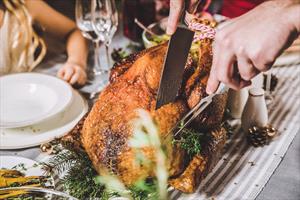Thanksgiving turkey being carved

Photo courtesy of Depositphotos
Being a veterinarian provides skills that sometimes extend beyond the clinical.
Every year, the holiday I look forward to the most is Thanksgiving. I celebrate it with my wife’s family: her uncle, cousins, brother. I discovered Thanksgiving when I emigrated from Australia to the U.S., and only wonder why Aussies don’t have a similar gorge-yourself-until-you-groan celebration of some historical event. I’ve even told my wife that in the event of a divorce, I get to go to Thanksgiving (she has told me that there won’t be a divorce, only a memorial service because they won’t even find the body).
Why am I bringing up Thanksgiving? Veterinary issues usually accompany various holidays (chocolate toxicity on Halloween or Easter, Super Bowl syndrome, pancreatitis, etc), forcing the vet in the family or the ER vet at work to reach for the emetics, pump out stomachs, sedate or anesthetize seizing pets instead of enjoying time with family. But for me, at least, there are skills that I possess that are exercised at Thanksgiving in particular.
Namely, carving the turkey.
It all started one year, soon after I met my wife (-to-be at that time) and accompanied her to Thanksgiving in a cabin in Vermont. Somehow, my avian anatomy knowledge from the first year of vet school made me, in the minds of my wife’s family, into a veritable turkey surgeon. I was handed a knife and told to operate. There I was, separating breast from breastplate, leg from thigh, wing from carcass. I did this with speed and precision apparently unseen before in this family. Ever since then, the “New Guy” (I’m still referred to as “New Guy” in the family, despite being married for 16 years) is given the task of dissecting the bird.
I have another veterinary skill that gets used occasionally, and, ironically enough, it’s also surgical although it’s the opposite of dissector-in-chief. I’m also the official, wife-appointed surgeon of dog toys.
It’s funny how most dogs, once they create a small hole in a stuffed toy, will eviscerate the entire thing in minutes. They might have played with the toy for months, or even years, but the moment there’s a flesh wound, the innards come out! My dog is no different. She has had her “duck” toy (it’s actually a pheasant, but she likes to think it’s a duck – after all she’s a duck dog, not some field hound!) for half her life. It’s now more of a brown-and-green stuffed football than a duck: no beak, no wings, no feet. All of those came off at some point. Each time, I was given the task of saving the duck-cum-pheasant. I have used my suturing training over and over, with simple continuous, mattress, Ford interlocking, and even cruciate stitch patterns, as required. I have done flap transpositions to close skin defects. I have amputated remnants of wings and feet because any small tag is an irresistible invitation to chew and tear. I have replaced eviscerated “viscera.” These days, the pheasant looks like Franken-duck, but thankfully not turducken. But this intermittent surgery keeps dog and wife happy. And that’s all that matters, isn’t it?
Well, that and the Thanksgiving turkey. Where’s my knife?